Although politically incorrect in this day and age, there is something to be said for the killing off of a couple of birds with only one stone, especially if they are crows and they eat all your birdseed…
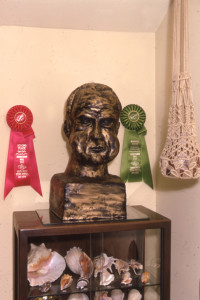 I’m actually a huge fan of one task doing double duty, it is really the most creative way to get things done. Even back in High School, I remember studying plaster casting in art class and I asked if I could make a plaster bust of our then president Richard Nixon. I got approval and then entered it into the History Fair at the end of the year, for a history class final, getting an A on the project twice, one for each class and receiving an award as well. The subject matter? Well there are no words… (I think it might still be in the attic…)
I’m actually a huge fan of one task doing double duty, it is really the most creative way to get things done. Even back in High School, I remember studying plaster casting in art class and I asked if I could make a plaster bust of our then president Richard Nixon. I got approval and then entered it into the History Fair at the end of the year, for a history class final, getting an A on the project twice, one for each class and receiving an award as well. The subject matter? Well there are no words… (I think it might still be in the attic…)
While still in High School, I thought it very efficient and profitable to do the hand work from my dressmaking business, while I was babysitting, after the kids would go to bed, getting paid twice so to speak for one job.
And so now, I’m in a position where I need to show a technique for a presentation I’m building and I might as well make double duty out of it.
First the background…
I was trained to make clothes by my mother, who was a fantastic tailor, and did almost everything by hand. Our sewing machine was simple, back and forth, could sew through anything, and there was a control and simplicity to how we did things. All of my linings were put in by hand. No exception. I like the control, the ability to shape, and fit one shell into another taking into account the inward curve of a garment in the round.
I’m building a very complex lecture for the American Sewing Guild conference in St. Louis the end of the month. The lecture is called “Behind the Front Lines” and is all about Underlinings, Interlinings, Linings, Interfacings, and Facings. The lecture itself is mostly finished. Just basic proofing. BUT… There is one technique that I haven’t explained, and I really really need to even though it goes against everything I’ve every been taught or enjoy.
Bagging a lining. Yep, that’s it. Kicking and screaming, I need to illustrate how to bag a lining even though I’d never actually want to do this technique, ever…
Let me explain since most of you are scratching your heads…
Bagging a lining is an industry technique that allows a lining to be installed completely by machine. It takes a bit of spacial acuity, and some good old fashioned alligator wrestling, but it is possible to put in a lining completely by machine with almost no handwork left. I have to show how to do it if I’m giving a lecture on the techniques of putting in linings. And it is killing me…
In addition to that lecture, I’m also doing my popular “Weave your own trim” on an inkle loom, for the same conference. For most in the class, I think it is almost full at 19, this is their first try at any kind of weaving and with the little Inkle Loom, they have instant success and can make cool trims for their jackets and home dec projects. I have an article coming out in the fall in Threads Magazine on just this topic. Threads actually has all my samples and garments at the moment from the photo shoot. I should have them back in time for the conference, but I digress…
I need another jacket with trim I’ve woven, especially one that looks like a Chanel Garment.
So off to my huge stash of patterns and pattern magazines… ( I go back to 1995 with the Burda Fashion magazines, now called Burda Style, all of the patterns for each of the 12 issues per year are contained within. We are starting the monumental task of cataloging what they contain…)
I found this simple jacket in December 2013. There are no words for the petersham/grosgrain trim…
I also found this lovely fabric that looks handwoven but is definitely not, I think I bought it a couple years ago on a trip to Osgood’s in Mass. I washed it up and gave it a good pressing.
And I pulled yarns from my stash and set my daughter up to sampling trim on the inkle loom.
Our first attempt was just OK. Nothing spectacular. Mostly Bamboo. Flat and unappealing…
The next attempt was better for the color. The middle pick up diamond popped a bit, and we thought with some tweaking it would probably be fine.
I set out to trace off the pattern from the magazine, fit it, and then cut out the fabric, lining, and fusible interfacing.
After dinner I went back to the inkle loom and started messing around with supplemental weft, in fact it is the same technique I’m teaching in the Weave Your Own Trim class. I really liked what was happening and with a little more tweaking, re-warped the loom and I’m on my way.
Everything is cut out and ready to assemble so I can start photographing the process of how to bag a lining… This should be completely entertaining and who knows, maybe there will be a convert among us…
Stay tuned… (and yes, I know almost every sentence ended with an ellipsis, I write like that…)
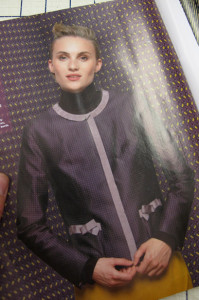
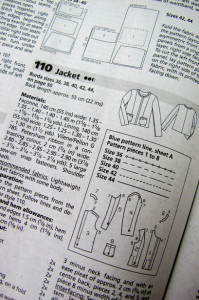
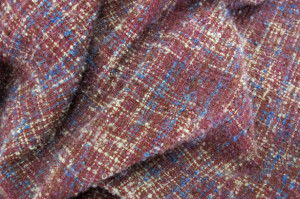
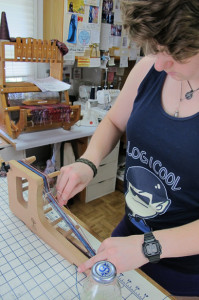
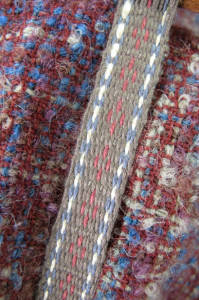
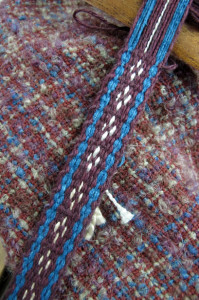
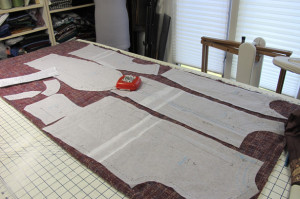
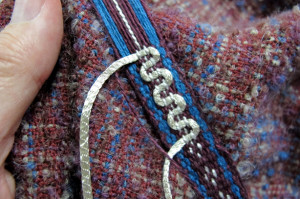
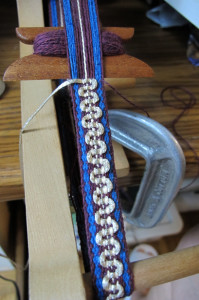
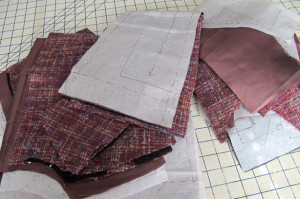
I love ellipsis(es)?
I actually did this a looooong time ago and can’t remember any details. All on the sewing machine except for the final lining hem that was separate from the garment hem as is proper and normal the way I learned to sew. I’m looking forward to seeing how you do it, it just takes pre-thought and not forging ahead and missing a step here and there and having to rip! Have fun!
Hmmmmmmmm…………….I really like the second one best!
Beautiful jacket pattern. Can’t wait to see yours when finished.
My vote is definately with the supplemental weft. The fabric is a fairly balanced mix of color, and I think it needs the “pop” of a bolder trim.
So cool to see the trim-making process!
BTW, Alan writes with ellipses, too, from his news-anchor days when they served to remind him where to take pauses 🙂
Interesting…..being ‘slightly’ dyslexic 🙂 it would take me several hours lying awake at night going over and over it and hopefully suddenly getting it!! I mean it seems simple enough…
Like the trim with the diamonds.
You write that way because you talk that way…we all do. Makes it so much friendlier and we like hearing your “voice.”
I’m willing to bet you will not convert yourself to bagged linings. Nothing matches the finishing techniques of hand sewing.